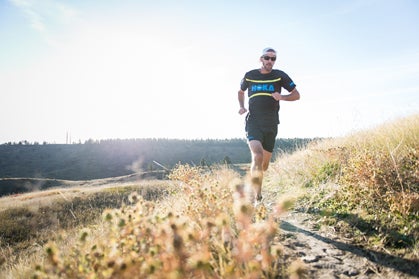The Speedgoat's Tips for Ultrarunning Longevity

Ultrarunners see more than their fair share of burnout, but Karl Meltzer has been going strong since the 90s. Here’s how he does it
Photo by Matt Trappe.
Has anyone been doing it better—for longer—than Karl “Speedgoat” Meltzer?
With 36 100-mile wins dating back to the 90s, Meltzer, 47, of Salt Lake City, Utah, is a shining example of longevity in ultrarunning. Many other top-level athletes have risen to prominence and faded away with overuse injuries or burnout in that same time.
Ultramarathons, after all, are brutally tough on your body; but whether driven by fun and friends (most of us) or pressure by sponsors (a select few), it’s easy to run too many of them, and train too much in between.
Resisting the call of the trail can be difficult. But if trail running is an important part of your life—and for a smaller percentage of people, if racing well is important to you—it is equally important to know when to pull back, so you can enjoy the trails for many years to come.
So Trail Runner asked Meltzer to share a few tips that have kept him racing and running well over the long haul. Here’s what he had to say.
1. Don’t race too much. “Some people do [over-race], but I think it’s because they are basically excited to just be on the trail. It becomes very addicting. When someone is running well, they never feel as though they are racing too much, until they finally break. I ran a lot of races in my day, but I did that on minimal training miles, and used the races as my big runs.”
2. After races, recover fully … “I wait till the soreness subsides, then go for a longer walk. I eat well, and often, and feel my body coming back. Sleep is also a key factor. I sleep a lot after longer races; this is when the body really ‘regrows’ back to normal. I usually will have one good run a few weeks after a race, and say I’ve ‘turned the corner’ on recovering.
3. … and don’t come back too fast. “Many people definitely have the itch to get back at it prematurely, especially after a good performance. I see this all the time with clients I coach, but I have to tell them to hold back the reins and respect recovery. What I do typically see for those that try to come back too fast is a good week almost directly after a good performance (running on adrenaline), then two weeks later they’re burnt and tired. I do my best to avoid that and keep the miles growing back super slow.”
4. Listen to your body. “I don’t overtrain between races, and I really listen to my body for signs of tiredness. If I need a break I take it. Each day I run, it’s generally on feel. I listen for signals of overuse injuries and address them immediately, instead of pushing through things.”
5. Take downtime. “I take a break each year in November-December and run much less. I may even run a race at that time, but it’s just for fun, not for competition.”